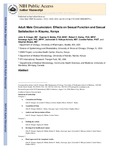| dc.description.abstract | INTRODUCTION:
Male circumcision is being promoted for HIV prevention in high-risk heterosexual populations. However, there is a concern that circumcision may impair sexual function.
AIM:
To assess adult male circumcision's effect on men's sexual function and pleasure.
METHODS:
Participants in a controlled trial of circumcision to reduce HIV incidence in Kisumu, Kenya were uncircumcised, HIV negative, sexually active men, aged 18-24 years, with a hemoglobin >or=9.0 mmol/L. Exclusion criteria included foreskin covering less than half the glans, a condition that might unduly increase surgical risks, or a medical indication for circumcision. Participants were randomized 1:1 to either immediate circumcision or delayed circumcision after 2 years (control group). Detailed evaluations occurred at 1, 3, 6, 12, 18, and 24 months.
MAIN OUTCOME MEASURES:
(i) Sexual function between circumcised and uncircumcised men; and (ii) sexual satisfaction and pleasure over time following circumcision.
RESULTS:
Between February 2002 and September 2005, 2,784 participants were randomized, including the 100 excluded from this analysis because they crossed over, were not circumcised within 30 days of randomization, did not complete baseline interviews, or were outside the age range. For the circumcision and control groups, respectively, rates of any reported sexual dysfunction decreased from 23.6% and 25.9% at baseline to 6.2% and 5.8% at month 24. Changes over time were not associated with circumcision status. Compared to before they were circumcised, 64.0% of circumcised men reported their penis was "much more sensitive," and 54.5% rated their ease of reaching orgasm as "much more" at month 24.
CONCLUSIONS:
Adult male circumcision was not associated with sexual dysfunction. Circumcised men reported increased penile sensitivity and enhanced ease of reaching orgasm. These data indicate that integration of male circumcision into programs to reduce HIV risk is unlikely to adversely effect male sexual function. | en |


